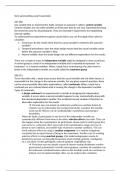Kom samenvatting vanaf tussentoets
267-282
Any variable that an experimenter holds constant on purpose is called a control variable.
Control variables are not really variables at all because they do not vary. Experimenters keep
the levels the same for all participants. They are essential in experiments for establishing
internal validity.
To understand how experiments support causal claims, you can first apply three rules for
causation:
1. Covariance: do the results show that the causal variable is related to the outcome
variable?
2. Temporal precedence: does the study design ensure that the causal variable comes
before the outcome variable in time.
3. Internal validity: does the study design rule out different explanations for the results.
There are a couple of ways an independent variable might be designed to show covariance.
A control group is a level of an independent variable that is intended to represent ‘’no
treatment’’ or a neutral condition. When a study has a control group, the other level or
levels of the independent variable are usually called the treatment group.
285-291
To be internally valid, a study must ensure that the causal variable and not other factors, is
responsible for the change in the outcome variable. For any given research question, there
can be several possible alternative explanations, called confounds. When a study has a
confound you are confused about what is causing the change in the dependent variable.
Types of confounds:
- A design confound is an experimenter’s mistake in designing the independent
variable, it occurs when a second variable happens to vary systematically along with
the intended independent variable. The accidental second variable is therefore an
alternative explanation for the results.
Verwijst naar een situatie in onderzoek waarbij een variabele buiten de
controle van de onderzoeker het resultaat beïnvloedt, waardoor het moeilijk
wordt om de effecten van de onafhankelijke variabele(s) nauwkeurig te
beoordelen.
- When the kinds of participants in one level of the independent variable are
systematically different from those in the other, selection effects can result. They can
also happen when the experimenters let participants choose (select) which group they
want to be in. a selection effect may result if the experimenters assign one type of
person to one condition, and another type of person to another condition. You can
avoid selection effects by using a random assignment. In a random assignment
everybody has an equal chance of being in the experiment. Another way of avoiding
selection effects is using matched groups. Zijn onderzoeksgroepen waarin de
deelnemers op basis van bepaalde kenmerken (zoals leeftijd, geslacht, intelligentie,
etc.) aan elkaar worden gekoppeld, zodat de groepen vergelijkbaar zijn.
Verwijzen naar een situatie waarin de manier waarop deelnemers worden
geselecteerd systematisch verschilt tussen groepen, waardoor de resultaten van
het onderzoek vertekend kunnen raken en het moeilijk wordt om conclusies te
trekken over het daadwerkelijke effect van de onderzochte variabelen.
, 303-311
4 types of validity
1. Internal validity
2. External validity
3. Construct validity
4. Statistic validity
Internal validity
Are there alternative explanations for the results?
Dit verwijst naar de mate waarin een onderzoek overtuigend bewijs levert dat de
onafhankelijke variabele daadwerkelijk verantwoordelijk is voor de waargenomen effecten op
de afhankelijke variabele, zonder beïnvloeding door confounds of storende factoren.
Experimenters isolate and manipulate a key causal variable, while controlling for all the other
possible variables, precisely so they can achieve internal validity. If the internal validity of an
experiment is sound, you know that a causal claim is almost certainly appropriate.
Threats to internal validity:
1. Did the experimental design ensure that there were no design confounds, or did some
other variable accidentally cover along with the intended independed variable?
2. If the experimenters used an independent-group design, did they control for selection
effects by using random assignment or matching?
3. If the experimenters used a within-groups design, did they control for order effects by
counterbalancing.
External validity
Dit gaat over de mate waarin de resultaten van een onderzoek kunnen worden gegeneraliseerd
naar andere situaties, populaties, tijden of plaatsen. Het is belangrijk als je wilt weten of de
bevindingen ook buiten de specifieke onderzoek context toepasbaar zijn.
You ask whether the causal relationship can generalize the other people, places and times. As
with an association claim or a frequency claim, when interrogating a causal claim’s external
validity, you should ask how the experimenters recruited their participants. Remember that
when you interrogate external validity, you ask about random sampling.
Construct validity
Dit verwijst naar de vraag of het onderzoek de juiste variabelen meet of manipuleert. Met
andere woorden, de mate waarin de gebruikte meetinstrumenten daadwerkelijk het
theoretische construct meten dat ze beogen te meten.
In an experiment, researchers operationalize two constructs: the independent variable and the
dependent variable. When you interrogate the construct validity of an experiment, you should
ask about the construct validity of each of these variables.
You can interrogate construct validity in the dependent variable by asking how well the
researchers measured their dependent variables: factual and conceptual knowledge. One
aspect of good measurement is face validity, verwijst naar de mate waarin een
meetinstrument op het eerste gezicht lijkt te meten wat het beoogt te meten. Het gaat om de
subjectieve inschatting of de test of vragenlijst logisch en passend lijkt voor het doel, zonder
diepgaande statistische of theoretische analyse.




